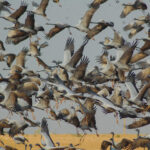Sitting with Neitzo, eating deep-fried silkworms on a stick, hearing him talk about how integral nature is to the tribal culture. Surrounded by Naga tribals, eating and drinking Thutse (local alcoholic beverages made of rice) with the smoke of wood fires wafting through the Morung. I didn’t see then the path Netizo and conversations with the tribals would set me on. An introspection into what we really need to find fulfillment and live in a sustainable civilization. A holistic view of our ecosystem, a deeper understanding of how we are a part of the natural world and not outside of it.

Quite often in our lives, on our individual timelines events transpire that we don’t fully understand at first. I had heard the name Hornbill only in passing. Not really understanding what it was and what it represents. I had a vague idea of it being a music festival of some kind.
After a year filled with travelling around India shooting for Luxury hotels, events, and venues the Hornbill Festival 2019 came as an exclamation mark at the end of the year. A much-needed pause and a peek through a window into the rich indigenous tribal cultures of Nagaland.

“So that you could walk from one tribe’s Morung into another an sit at the campfire with five different tribe members and debate the right way of making Axone (pronounced Akhuni).”
If the sixteen indigenous Naga tribes decided to hold an annual ten-day festival where they would gather together and exchange culture, knowledge, and stories. If they then decided to open it up for all to come and learn the rich indigenous Naga culture. To sit, talk, dance, sing, laugh, eat, and drink together. So that you could walk from one tribe’s Morung into another and sit at the campfire with five different tribe members and debate the right way of making Axone (pronounced Akhuni). If this festival then happened to grow over the years into a cultural extravaganza showcasing everything from indigenous culture to modern-day Nagaland culture. Spanning several venues, locations and covering two cities. This is what the Hornbill Festival is today, it is everything Naga.

The name itself; Hornbill is driven by ecological conservation. The Hornbill bird holds significant cultural importance for almost all of the 17 major indigenous tribes of Nagaland. A symbol of respect, prestige, honour, fertility, and the balance of the ecology. It is said that the Ao Naga tribe’s practice of mourning for the dead which culminates with taking a bath in the river on the sixth day after the death, is based on the behaviour of Naga Hornbills. Some tribes invoke blessings and abundance ‘as a flock of hornbills’. Its feathers were worn in headgear and jewellery.
Sadly, excessive hunting had pushed the hornbill to near extinction in Nagaland. Recent conservation efforts have led to hunters becoming protectors. These efforts are slowly showing results with hornbill sightings in the wild being reported in the remote forests of Nagaland.

The ten-day festival is usually held from the 1st to the 10th of December. It takes place at Kisama Heritage Village. 12kms south of Kohima, the capital of Nagaland. I got there from Dimapur by car. Although the festival of Hornbill takes place at Kisama Village, events, and extensions of the festival happen in both Kohima and Dimapur. I was staying at Mr Paul Reno’s perfect homestay in Jotsuma village, 8kms from Kisama.
Mr Paul’s homestay proved to be the idyllic village homestay I needed for my exclamation mark of a journey.
The Reno family home is perfectly looked after and an ideal stay for those who would prefer a quiet village to rest in, over the comparatively bustling Kohima city. They have pigs. (I am told everyone owns at least one), chickens and a whole bunch of kitchen vegetables growing on their property. Complete with hot water and the most sublime mountainside view over Jotsuma village and Kohima city. I spent my nights staring out at this view while pondering everything I was experiencing and learning.
Since I made it to Mr Pauls just after sunset, he recommended heading to the Hornbill night market in Kohima instead of heading to Kisama Village. Recommending I take on Kisama Village with a fresh start early the next day. A highly appreciated recommendation in retrospect. One requires a fresh mind to effectively take in all the sensory inputs at the Hornbill Festival.

Neitzo from the Angami tribe was going to show me around during my visit. On the ride over from the airport, we managed to get along really well. Talking about everything from his experiences of staying in the city of Delhi to the rituals and teachings of his tribe. Neitzo is about my age, yet we did have some considerable differences in persons. To begin with, he didn’t indulge in any of the vices I was prone to. Those are considered every day in urban lives. A combination of friends, tribal bonds, community responsibilities, spirituality (devout catholic) and being in nature is what bought him fulfilment. At the same time, he seemed to struggle between how he feels, and how society defines success and happiness in the 21st century, driven by a globalized consumer market.
“Once upon a time, hunted scalps were worn as necklaces by proud head hunters in these lands.”
Nagaland is no stranger to globalization and its market, ecological and societal implications. But the Nagas haven’t given in as easily as others may have. That being said it has fought this battle for far too long. Fighting against the exploitation of their land and natural resources.
The Nagas do not give in to defeat easily. Here valour is measured by the number of feathers on one’s headgear. Once upon a time, hunted scalps were worn as necklaces by proud head hunters in these lands. The traditional ceremonial attire of each tribe is a clarion call

The word Naga is believed to have been borne of the Burmese word “Naka” which means the race with perforated ears and hints at the practice of using wooden lugs as earrings. As warriors, one of their golden moments was during the British rule, in 1944, when the Nagas with unhindered courage and intelligence helped the British beat down nearly 13000 Japanese soldiers from the present day, state capital – Kohima. The site of one of the war’s bloodiest battles, Garrison Hill, now has a War Cemetery with memorials to martyred soldiers. Many of these casualties were Nagas (mostly belonging to the Angami tribe). The only Naga grave at the cemetery is that of 21-year-old Saliezhu Angami with an epitaph that reads, “The big-minded warring youngest son of mine shall arise and shine like a star.
“Cooked by women of the Rongmei tribe – who were part of the tribal troop that was attending the Hornbill festival”
At the Kohima Night Bazaar, on my insistence Neitzo managed to find us a wholesome meal of snail curry, with rice and stewed vegetables and pickles. He wasn’t sure I would enjoy my meal, surely the reactions of urban dwellers had made an impression on him.
Cooked by women of the Rongmei tribe – who were part of the tribal troop that was attending the Hornbill festival. It was spicy and reminded me of a Calcutta Fish curry. We managed to get a side of silkworms in a chutney. Silkworms went on to become my new favourite dish over the next few days.

While the globalized western culture considers the eating of insects and other non-mainstream animals taboo, Entomophagy is practised by two billion people daily. It’s only a matter of what we are used to seeing and considering as ok to eat. Additionally, the practice of entomophagy and consumption of non-mainstream local meats is a very viable manner in which we can deal with the climate and hunger crisis we face today
“We may consume that which is available but as long as we do it in moderation.”
To the Naga tribes, it has always been a matter of making sustainable use of the nature around them. Humans are a part of the ecology, and we have our place in it. We may consume that which is available but as long as we do it in moderation. Aware of our function in nature, our place.
This trip was my first time eating snails, silkworms or caterpillars. And I took to it instantly, it was wholesome, nutritious and fulfilling. These ingredients have been consumed for centuries and the various tribes have distinct and delectable ways of preparing them.
While there are vendors plying goods at the night bazaar, they can easily be avoided since Kisama Village has various sections dedicated to the sale of traditional and indigenous wares. There are some shows and performances that can be enjoyed, and a large selection of street food.

After a year marked with five-star breakfasts on hotel shoots, the contrast of local sweet bananas, toast, eggs and chai prepared by the Reno Family, was just what was needed to get me into the right mindset for Hornbill festival early the next morning.
Neitzo and I made it to the Morungs at the Hornbill Festival early in the day. We decided that he would go meet some friends and let me explore by myself. I always found that it was easier to approach people when you were by yourself. Easier to strike up conversations and learn things. Plus, when Netizo was around I was treated as a tourist with a guide. I preferred avoiding that.
“This was my first introduction to the tribal ecological knowledge and responsibility held by the 17 indigenous tribes of Nagaland.”
At the main stage area at Kisama village, every morning ‘Cultural Connect’ takes place for about four hours. These are cultural performances, workshops and demonstrations by various tribes with the objective of connecting through these stories with all the other tribes and visitors of the festivals.

Every tribe puts together a performance representative of their particular culture, ecology and history. This was my first introduction to the tribal ecological knowledge and responsibility held by the 17 indigenous tribes of Nagaland. Their reverence for their environment was woven into the stories they performed. Some tribes performed demonstrations to showcase rituals and traditions.



Ao tribe’s performance of a Hornbill dance is breathtaking. They imitate a Hornbill bird flying in the forest. Flying from tree to tree, looking for the right tree to rest on. The movements of the legs and hands during the dance are inspired by the movements of the Hornbill
In our arrogance, we often overlook the fact that absolutely all of the knowledge and traditions possessed by indigenous communities are based on a deeper understanding of the nature around them. If humans have to survive in nature for centuries – as all human beings did at some point in history – it would only be possible through a deeper understanding of the nature around us. This is how some indigenous communities still survive in nature today, while you read this on a device with artificial lighting and I type with Grammarly correcting my sentence construction.
“Traditionally if indigenious people required wood they would allow a Hornbill bird to guide them.”
Traditionally if indigenous people required wood they would allow a Hornbill bird to guide them. Following her as she flew looking for a tree to rest at. When she would rest on a branch and settle on it, they would then only cut that branch. If it was good enough/ heavy enough for her to rest on it was good enough for them to use. Conservation is built into tradition. They did not cut and kill the entire tree, they found a way to coexist. Take the wood, but don’t destroy the forest because the forest is what gives. The forest is sacred.
Soon after I wandered into the Morungs of Hornbill. Here we must pause and first talk about what Morungs are. For when I say I wandered into the Morungs of Hornbill you wouldn’t understand the warm, enveloping, safe, social and rich in the ancient culture of an environment I had just wandered into.

Morungs were structures, sometimes large tents and often fixed permanent wooden structures like those seen at Hornbill festival. In Naga tribal communities these acted as dormitories for boys that were coming of age. Various members in the communities would help determine the right time for admitting a boy into a Morung.
It was considered a Right Of Passage from boyhood to adulthood. Here they would learn the ways of their people. The traditions, songs and dances. Spiritual practices were taught. Warriors were made here. The tribal elders in this way manage to ensure the survival of their community. By ensuring the next generation had all the tools and knowledge at their disposal to survive in their environment.
“This was by design, the founders of Hornbill Festival intended it to be a Morung for all the tribes of Nagaland, to come together peacefully and exchange culture and knowledge.”
Here I wasn’t a tourist, no one was. Everyone was just part of the festival. I was later told by an old and slightly inebriated tribal elder, that that is the feeling of being in a village Morung. In the Morung the entire community belongs, no one was an outsider. In fact, outsiders weren’t allowed in the village Morung. The area at Kisama village Morung area is a giant Morung in itself, no one is an outsider here. This was by design, the founders of Hornbill Festival intended it to be a Morung for all the tribes of Nagaland, to come together peacefully and exchange culture and knowledge. Traditionally similar festivals take place in indigenous communities globally. These were highly significant events organised during extended periods of peace. Trade, knowledge and culture were exchanged. This environment also allowed for inter-tribal marriages.

We lack Morungs in modern society. As a species, we have evolved to learn from our elders. They show us how to survive, what to eat and what not to. Care for us and protect us when we are vulnerable.
One of the areas of concern in modern society especially highlighted in the millennial and post-millennial generation is the extension of adolescence. Childhood stretches on for a longer period of time. A century ago it was thought to end around the age of 18 to 21, today psychologists worry that a state of adolescence might extend into the 30s and even in some cases 40s. This is additionally exasperated by modern media/marketing trends and the effects of social media usage.

All traditions, religions and cultures have a rite of passage rituals. A common thread was an experience that involved emotional and/or physical pain, significant exchange of knowledge and rituals that marked a new beginning. An important role it played was to inform one of their place in that society and community. That they weren’t just an individual, they were part of society. They had others they had responsibilities toward and could also depend on “Indigenous varieties of good grains passed down for generations and 17 different variations of Axone.” In the Morungs of Hornbill I found immense knowledge about everything from food to natural construction materials. Indigenious varieties of good grains passed down for generations and 17 different variations of Axone. Tribal elders to share Thutse over a campfire with. While we ate a bowl of spicy silkworm chutney, or enjoyed some fresh snail broth together. At the Sangtam Morung, Bongtang told me how it was his imperative as a Tribal elder to ensure that there was enough to provide for the next generations of their tribe. They didn’t only think of those that were alive, but also those to come and the resources they would need. I watched as he expertly pulled the snail through in one quick swoosh, while I struggled to master the technique of sucking a snail in a single go.

The night sky took over, and some Morungs played the latest pop songs, people were laughing, dancing and having a festive time. At the main stage, rock music played, and a tribal elder looked out at the new Naga generation dancing to songs they didn’t understand.
I found Chakhesang Morung talking to a group of friends from a local college. We all spoke in fluent English, took selfies and followed each other on Instagram. We laughed and ate some Caterpillars I had bought from the Lotha Morung.
We decided to join a growing crowd at the Angami Morung’s bonfire. Here I was offered some squirrel and deer meat by a sweet couple from Kohima city. I eventually got lost in a conversation with a tribal elder seated at the campfire. We discussed the state of global ecology and whether we had any hope of dealing with the climate crisis. He told me how he felt that we exist because the forest exists, and if the forest ceases to exist then we too must cease to exist, he wasn’t too worried about it. For as long as he was alive, the forest would be alive as well, he would protect it.

Neitzo and a few of his friends found me here. We proceeded to eat and talk as only those who are merry and beside a campfire can talk. I found myself delaying our departure back to Mr Paul’s homestay. I would be leaving the next morning for Dimapur. Then a flight to Kolkata, followed by a flight to Mumbai. Where I would stay for about ten hours, followed by a flight to Gwalior for a friend’s wedding.
The comparatively simpler lifestyles, much deeper understanding of nature, community sense and immense practical knowledge of the Tribes of Nagaland made me think about my own life. What is my tribe really? Is it the brand of my smartphone or the sports team I support? I was clearly not living like I understood that I was a part of the ecology surrounding me.
The smoke from the campfire was comforting me for some reason. Making me feel relaxed, calm and at home. For long after Hornbill the smell of burning wood would take me back into the warm embrace of a Morung. I didn’t want to leave the campfire. I didn’t want to leave the Morungs, with their ancient knowledge and protective elders.
I finally managed to get myself up, only by promising myself that I would make my way back here to the Morungs on December first of the following year.











